Content for TS 23.283 Word version: 18.1.0
1…
10…
10.2…
10.2.2…
10.2.3…
10.3…
10.3.3…
10.3.3.7…
10.3.4…
10.3.4.4…
10.3.5…
10.3.5.8…
10.3.6…
10.3.7…
10.3.7.5…
10.3.8…
10.4…
10.4.4…
10.5…
10.5.7…
10.6…
10.6.2…
10.6.2.3…
10.6.3…
10.6.4…
10.7…
10.8…
10.11…
10.11.4…
10.12…
10.14…
10.15…
10.3.7 Group regroup with pre-configured group
10.3.7.1 General
10.3.7.2 Regroup formation using pre-configured group
10.3.7.2.1 Regroup formation using pre-configured group initiated in the MCPTT system
10.3.7.2.2 Regroup formation using pre-configured group initiated in the IWF
10.3.7.3 Regroup cancellation using pre-configured group regroup
10.3.7.3.1 Regroup cancellation using pre-configured group initiated in the MCPTT system
10.3.7.3.2 Regroup cancellation using pre-configured group initiated in the IWF
10.3.7.4 Regroup rejection using pre-configured group
10.3.7.4.1 Regroup rejection using pre-configured group for regroup initiated in the MCPTT system
10.3.7.4.2 Regroup rejection using pre-configured group for regroup initiated in the IWF
...
...
10.3.7 Group regroup with pre-configured group |R16| p. 72
10.3.7.1 General p. 72
A group regroup may be achieved by regrouping MCPTT groups into a new regroup group which uses the configuration of a separate pre-configured MCPTT group. The MCPTT group configuration needs to be provided to the relevant MCPTT group members of the MCPTT groups that will be regrouped in advance of the regrouping operation.
The pre-configured MCPTT group that provides the configuration is not used as the pre-configured group regroup itself, it only provides configuration for one or more pre-configured group or user regroup. The MCPTT group ID of the pre-configured group regroup is provided by the authorized user or the IWF (for the case where the IWF owns the pre-configured group regroup) when the pre-configured group regrouping is carried out.
The pre-configured group regroup can be specified to be a broadcast or non-broadcast type according to the configuration of the MCPTT group whose configuration is specified by the pre-configured group regroup request. The broadcast type of pre-configured group regroup is used for one-way communication where only an authorized user or the IWF (for the case where the IWF owns the pre-configured group regroup) is allowed to transmit and all other regroup members are only allowed to receive the communication (e.g. a call from a dispatcher to all regroup members). The non-broadcast type is used for two-way communication where all regroup members can transmit and receive (i.e, the pre-configured group regroup call behaves like a normal non-broadcast group call).
These procedures provide a regrouping service for MCPTT only and are independent of group regrouping procedures specified in subclause 10.2.2. If one of the MCPTT groups that has been requested for regrouping by means of this procedure has already been regrouped by the group regrouping procedure specified in TS 23.280 or subclause 10.2.2, the request for regrouping shall be rejected. The rules for regrouping set forth in subclause 10.2.2.5 apply.
10.3.7.2 Regroup formation using pre-configured group p. 73
10.3.7.2.1 Regroup formation using pre-configured group initiated in the MCPTT system p. 73
Figure 10.3.7.2.1-1 illustrates the procedure to initiate a regroup procedure using a pre-configured MCPTT regroup group, where at least one of the groups to be regrouped is configured in the IWF. The group management server in the MCPTT system of the regroup group shares the necessary security related parameters together with the group configuration of the pre-configured group regroup with the group management server in the IWF; the MCPTT system does not need to be aware of the group members of the pre-configured group regroup that are receiving service in the IWF.
The procedure takes place prior to the establishment of a group call to the pre-configured group regroup.
In this procedure, any gateway MC servers between the IWF and the MCPTT system are not shown.
Pre-conditions:
- The MCPTT client is authorized to initiated a pre-configured group regroup procedure, and is receiving MCPTT service in the MCPTT system.
- The MCPTT group identity and group configuration for the pre-configured group regroup have been pre-configured in the IWF, and the IWF has received the relevant security related information to allow communication in the pre-configured group regroup.
- In order to be aware whether the group is regrouped, the MCPTT server is subscribed to the group configuration in GMS.
- The GMS has subscribed group dynamic data as specified in subclause 10.1.5.5.1 in TS 23.280 from the MCPTT server within the same MCPTT system using the procedures defined in subclause 10.1.5.6 in TS 23.280.
- The IWF is affiliated to one or more of the MCPTT groups that will be regrouped; and/or, the IWF may own one or more of MCPTT groups to be regrouped.
- The pre-configured group regroup is homed in the MCPTT server.
- The IWF is home to at least one group that's a constituent group of the pre-configured group regroup.
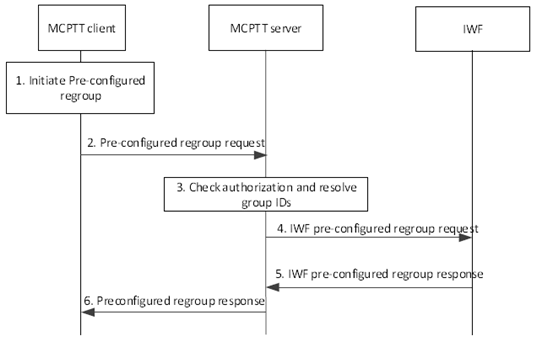
Figure 10.3.7.2.1-1: Regroup procedure using pre-configured group initiated in the MCPTT system
(⇒ copy of original 3GPP image)
(⇒ copy of original 3GPP image)
Step 1.
After the pre-configured group regrouping procedure, the regrouping remains in effect until explicitly cancelled by the procedure in subclause 10.3.7.3.
Participation by the IWF in the ongoing pre-configured group regroup persists until the IWF is no longer affiliated to any of the regrouped groups.
The authorized user of the MCPTT client initiates the pre-configured group regroup procedure, specifying the list of MCPTT groups to be regrouped including MCPTT group 1, the MCPTT group ID of the pre-configured group regroup and the MCPTT group ID of the group from which configuration information for the pre-configured group regroup is to be taken.
Step 2.
The MCPTT client sends the pre-configured regroup request to the MCPTT server.
Step 3.
The MCPTT server checks that the MCPTT client is authorized to initiate a pre-configured group regroup procedure, and resolves the group identities of the MCPTT groups requested in step 1. The MCPTT server also checks which group members are affiliated to the requested MCPTT groups that are homed in the MCPTT system. The MCPTT server identifies any partner systems or IWFs which are the group home systems for MCPTT groups identified in the list of groups to be regrouped. The MCPTT server may retrieve the configuration for the regroup group from the GMS if that configuration information is not already known to the MCPTT server.
Step 4.
The MCPTT server sends an IWF pre-configured regroup requests to the IWF.
Step 5.
The IWF sends an IWF pre-configured regroup response to the MCPTT server. The IWF may reject the IWF group regroup response. (e.g. if one of its constituent groups is in the emergency state or is already in a regroup, if the IWF does not support temporary groups or the IWF does not support group regrouping)
Step 6.
The MCPTT server sends the pre-configured regroup response to the MCPTT client.
10.3.7.2.2 Regroup formation using pre-configured group initiated in the IWF p. 75
Figure 10.3.7.2.2-1 illustrates the procedure to initiate a pre-configured group regroup procedure using a pre-configured MCPTT group, where at least one of the groups to be regrouped is configured in an MCPTT system. The group management server in the IWF shares the necessary security related parameters together with the group configuration of the MCPTT regroup group with the group management server in the MCPTT system and the group management server in the MCPTT system distributes this configuration including those security parameters to its served MCPTT users according to the procedures in subclause 10.2.7 of TS 23.280; the IWF does not need to be aware of the list of group members of the pre-configured group regroup that are receiving service in the MCPTT system. The group can have multiple MCPTT clients, but only one MCPTT client involved in the session is shown for simplicity.
The procedure takes place prior to the establishment of a group call to the pre-configured group regroup.
In this procedure, any gateway MC servers between the IWF and the MCPTT system are not shown.
Pre-conditions:
- The MCPTT client is an affiliated member of MCPTT group 1 where MCPTT group 1 is defined in the MCPTT system.
- The MCPTT group identity and group configuration for the pre-configured group regroup have been pre-configured in the MCPTT client, and the MCPTT client has received the relevant security related information to allow communication in the pre-configured group regroup.
- The pre-configured group regroup is homed in the IWF.
- The MCPTT system is home to at least one group that's a constituent group of the pre-configured group regroup.
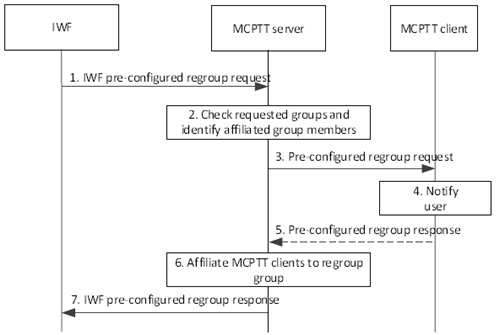
Figure 10.3.7.2.2-1: Regroup procedure using pre-configured group initiated in the IWF
(⇒ copy of original 3GPP image)
(⇒ copy of original 3GPP image)
Step 1.
After the pre-configured group regrouping procedure, the regrouping remains in effect until explicitly cancelled by the procedure in subclause 10.3.7.3.
MCPTT client participation in the ongoing pre-configured group regroup persists until the MCPTT client is no longer affiliated to any of the regrouped groups.
MCPTT client affiliation to the pre-configured group regroup may cease when the clients MCPTT service ceases, e.g. when the UE is powered down, or by the client performing a log-off operation.
The IWF initiates the pre-configured group regroup procedure, specifying the list of MCPTT groups to be regrouped including MCPTT group 1, the MCPTT group ID of the pre-configured group regroup and the MCPTT group ID of the group from which configuration information for the pre-configured group regroup is to be taken. The IWF sends the IWF pre-configured regroup request to the MCPTT server in the partner MCPTT system.
Step 2.
The MCPTT server checks the status of any MCPTT groups hosted by itself, and identifies affiliated group members of any of the identified MCPTT groups (both MCPTT groups that are hosted in the MCPTT system and MCPTT groups that are hosted in the IWF) that are receiving MCPTT service in the MCPTT system, which includes the MCPTT client.
Step 3.
The MCPTT server sends a pre-configured regroup request to the MCPTT client.
Step 4.
The MCPTT client notifies the user of the regrouping.
Step 5.
The MCPTT client 2 may send the pre-configured regroup response to the MCPTT server to acknowledge the regrouping action. This acknowledgement is not sent in response to a multicast transmission of the pre-configured regroup request.
Step 6.
The MCPTT server affiliates the regrouped MCPTT client to the pre-configured group regroup.
Step 7.
The MCPTT server sends an IWF pre-configured regroup response to the IWF.
10.3.7.3 Regroup cancellation using pre-configured group regroup p. 76
10.3.7.3.1 Regroup cancellation using pre-configured group initiated in the MCPTT system p. 76
Figure 10.3.7.3.1-1 illustrates the procedure to cancel a regrouping that uses a pre-configured MCPTT regroup group where there the regroup had been initiated in the MCPTT system.
Pre-conditions:
- The IWF has been regrouped into the pre-configured group regroup.
- The MCPTT client is authorized to cancel a pre-configured group regroup.
- The GMS has subscribed to the group dynamic data specified in subclause 10.1.5.5.1 of TS 23.280 from the MCPTT server as specified in subclause 10.1.5.6 of TS 23.280.
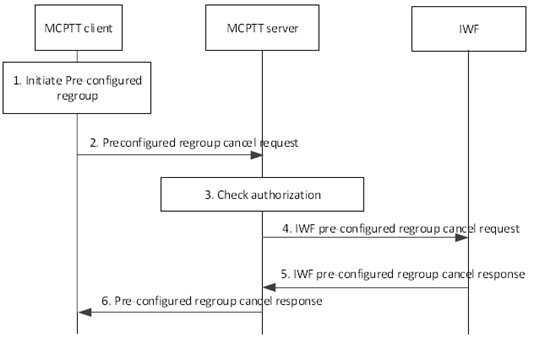
Figure 10.3.7.3.1-1: Regroup cancellation using pre-configured group initiated in the MCPTT system
(⇒ copy of original 3GPP image)
(⇒ copy of original 3GPP image)
Step 1.
The authorized user of the MCPTT client initiates the cancellation of the pre-configured group regroup.
Step 2.
The MCPTT client sends the pre-configured regroup cancel request to the MCPTT server, specifying the MCPTT group ID of the regroup group.
Step 3.
The MCPTT server checks that the MCPTT client is authorized to cancel a pre-configured group regroup.
Step 4.
The MCPTT server sends the IWF pre-configured regroup cancel request to the IWF.
Step 5.
The IWF sends the IWF pre-configured regroup cancel response to the MCPTT server. The IWF may reject the IWF group regroup response. (e.g. if one of its constituent groups is in the emergency state or is already in a regroup, if the IWF does not support temporary groups or the IWF does not support group regrouping)
Step 6.
The MCPTT server sends a pre-configured regroup cancel response to the MCPTT client.
10.3.7.3.2 Regroup cancellation using pre-configured group initiated in the IWF p. 77
Figure 10.3.7.3.2-1 illustrates the procedure to cancel a regrouping that uses a pre-configured MCPTT group where the regroup is initiated in the IWF. Only one MCPTT group member is shown for simplicity.
Pre-conditions:
- The MCPTT client has been regrouped into a pre-configured group regroup, and is receiving MCPTT service in the MCPTT system.
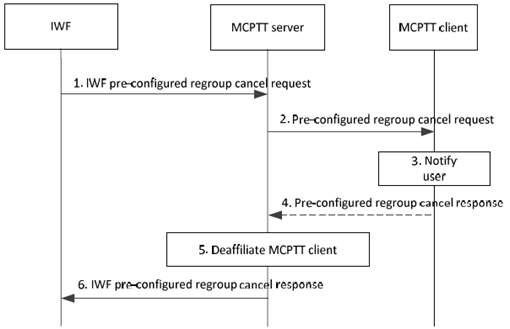
Figure 10.3.7.3.2-1: Cancel pre-configured group regroup procedure using pre-configured group in the MCPTT system
(⇒ copy of original 3GPP image)
(⇒ copy of original 3GPP image)
Step 1.
The IWF initiates the cancellation of the regrouping that uses a pre-configured MCPTT group. The IWF sends the IWF pre-configured regroup cancel request to the MCPTT server, specifying the MCPTT group ID of the regroup group.
Step 2.
The MCPTT server sends the pre-configured regroup cancel request to the MCPTT client.
Step 3.
The MCPTT client notifies the user of the cancellation of the pre-configured group regrouping.
Step 4.
The MCPTT client may send the pre-configured regroup remove response to the MCPTT server to acknowledge the cancellation of the pre-configured group regrouping. This acknowledgement is not sent in response to a multi-cast transmission of the pre-configured regroup cancel request.
Step 5.
The MCPTT server de-affiliates the MCPTT client from the pre-configured group regroup.
Step 6.
The MCPTT server sends the IWF pre-configured regroup cancel response to the IWF.
10.3.7.4 Regroup rejection using pre-configured group p. 78
10.3.7.4.1 Regroup rejection using pre-configured group for regroup initiated in the MCPTT system p. 78
Figure 10.3.7.4.1-1 illustrates the case where the procedure to initiate a pre-configured group regroup procedure with an MCPTT system and an IWF using a pre-configured MCPTT group described in subclause 10.3.7.3.1 commences, but where the request for the regroup is rejected by the IWF, for example because one of the groups hosted by the IWF is already regrouped by other group regrouping procedures.
In this procedure, any gateway MC servers between the IWF and the MCPTT system are not shown.
Pre-conditions:
- The MCPTT client is authorized to initiate a pre-configured group regroup procedure.
- The MCPTT group identity and group configuration for the pre-configured group regroup have been pre-configured in the IWF, and the IWF has received the relevant security related information to allow communication in the pre-configured group regroup.
- In order to be aware whether the group is regrouped, the MCPTT server is subscribed to the group configuration in GMS.
- The GMS has subscribed group dynamic data as specified in subclause 10.1.5.5.1 in TS 23.280 from the MCPTT server within the same MCPTT system using the procedures defined in subclause 10.1.5.6 in TS 23.280.
- The IWF is affiliated to one or more of the MCPTT groups that will be regrouped; and/or, the IWF may own one or more of MCPTT groups to be regrouped.
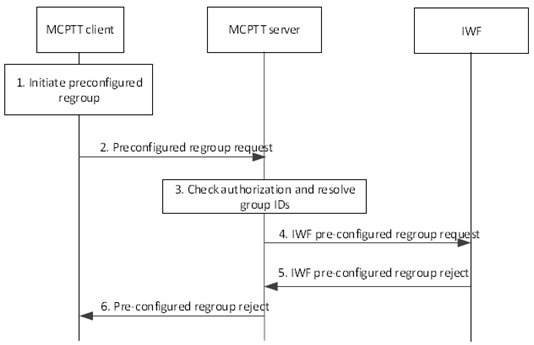
Figure 10.3.7.4.1-1: Regroup rejection using pre-configured group for group initiated in the MCPTT system
(⇒ copy of original 3GPP image)
(⇒ copy of original 3GPP image)
Step 1.
The authorized user of the MCPTT client initiates the pre-configured group regroup procedure, specifying the list of MCPTT groups to be regrouped including MCPTT group 1, the MCPTT group ID of the pre-configured group regroup and the MCPTT group ID of the group from which configuration information for the pre-configured group regroup is to be taken.
Step 2.
The MCPTT client sends the pre-configured regroup request to the MCPTT server.
Step 3.
The MCPTT server checks that the MCPTT client is authorized to initiate a pre-configured group regroup procedure, and resolves the group identities of the MCPTT groups requested in step 1. The MCPTT server also checks which group members are affiliated to the requested MCPTT groups that are homed in the MCPTT system. The MCPTT server identifies any partner systems or IWFs which are the group home systems for MCPTT groups identified in the list of groups to be regrouped. The MCPTT server may retrieve the configuration for the pre-configured group regroup from the GMS if that configuration information is not already known to the MCPTT server.
Step 4.
The MCPTT server sends the IWF pre-configured regroup requests to the IWF.
Step 5.
The IWF sends a pre-configured regroup reject to the MCPTT server, indicating the reason for rejection, for example because one or more of the MCPTT groups has already been regrouped by another group regrouping procedure, either internal to the IWF or in an MCPTT system.
Step 6.
The MCPTT server sends a pre-configured regroup reject to the MCPTT client, indicating the reason for the rejection.
10.3.7.4.2 Regroup rejection using pre-configured group for regroup initiated in the IWF p. 79
Figure 10.3.7.4.2-1 illustrates the case where the procedure to initiate a regroup procedure with an MCPTT system and an IWF using a pre-configured MCPTT group described in subclause 10.3.7.3.2 commences, but where the request for the pre-configured group regroup is rejected by the MCPTT system, for example because one of the groups hosted by the MCPTT system is already regrouped by other group regrouping procedures.
In this procedure, any gateway MC servers between the IWF and the MCPTT system are not shown.
Pre-conditions:
- The MCPTT client is an affiliated member of MCPTT group 1 where MCPTT group 1 is defined in the MCPTT system.
- The MCPTT group identity and group configuration for the pre-configured group regroup have been pre-configured in the MCPTT client, and the MCPTT client has received the relevant security related information to allow communication in the pre-configured group regroup.
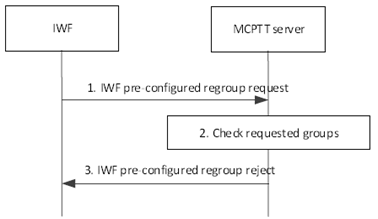
Figure 10.3.7.4.2-1: Regroup rejection using pre-configured group for group initiated in the IWF
(⇒ copy of original 3GPP image)
(⇒ copy of original 3GPP image)
Step 1.
The IWF initiates the pre-configured group regroup procedure, specifying the list of MCPTT groups to be regrouped including MCPTT group 1, the MCPTT group ID of the pre-configured group regroup and the MCPTT group ID of the group from which configuration information for the pre-configured group regroup is to be taken. The IWF sends the IWF pre-configured regroup request to the MCPTT server.
Step 2.
The MCPTT server checks the status of any MCPTT groups hosted by that MCPTT server, and determines that one or more requested MCPTT groups has already been regrouped by another group regrouping procedure.
Step 3.
The partner MCPTT server sends an IWF pre-configured regroup reject to the IWF, indicating the reason for rejection.